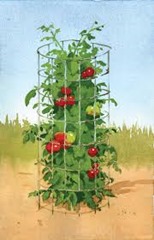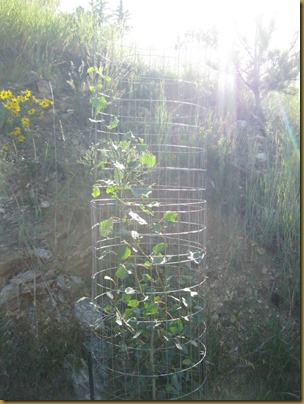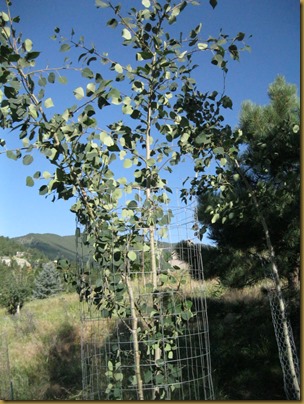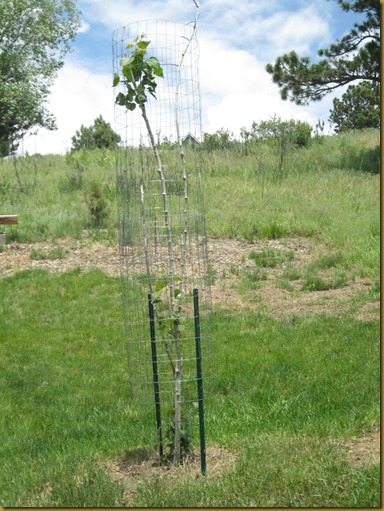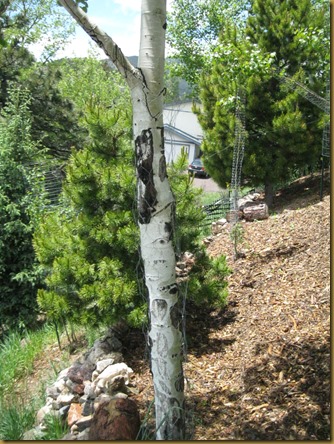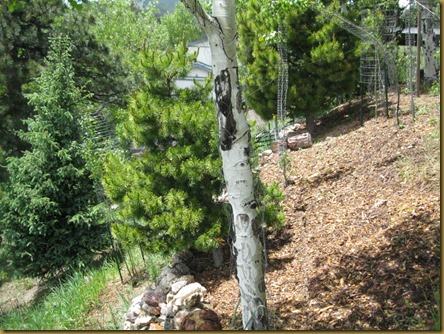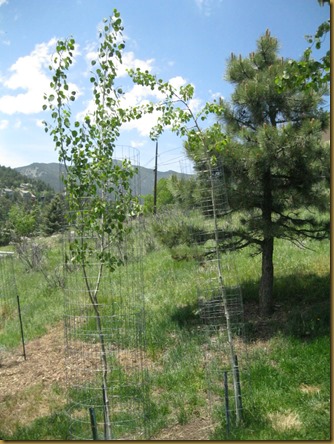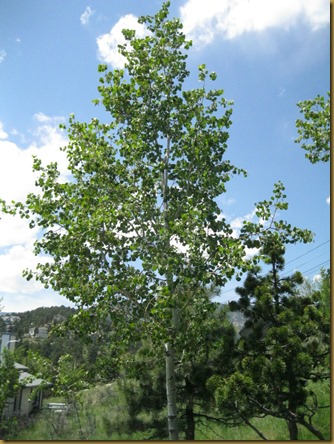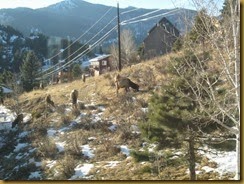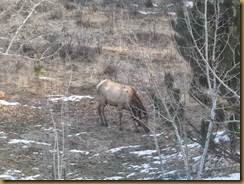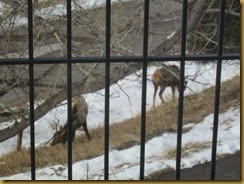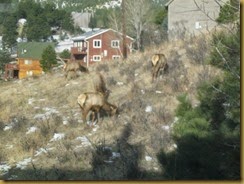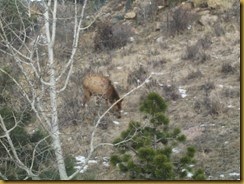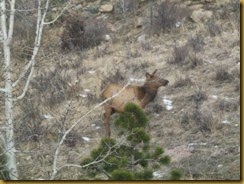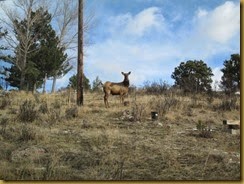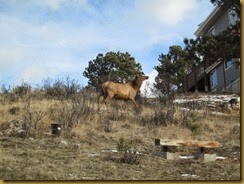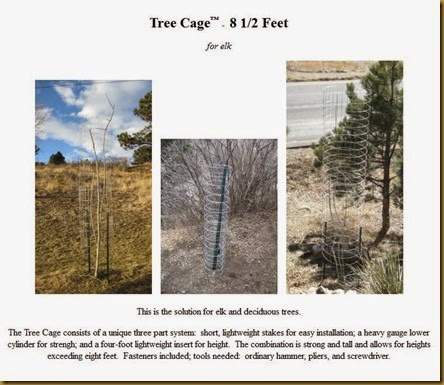http://iaf.tv/2015/10/14/nobody-tell-him-thats-not-a-unicorn/?_ga=1.106308483.1886893194.1444825448
Wednesday, October 14, 2015
Wednesday, July 29, 2015
Thursday, June 25, 2015
Linden
This linden tree is growing back after the top was eaten-off by the beasts. Unlike an aspen, it is only growing through suckers from the bottom. Very often aspen will grow back much higher up, if they are protected. Below is a three-stem clump that is growing back with the aid of a Tree Cage.
Angry Female
The closest I have ever come to being attacked. I grabbed a wooden crate and held it up to get into my house. She walked toward me and lurched strongly, several times. The day before I saw her twice (she came back) in a neighbor’s yard.
A pregnant beast.
Saturday, June 6, 2015
On Tree Protectors (part 2)
Have you ever wondered why you don’t see the large Tree Protectors on eBay anymore?
This may be a better solution: 2” chicken wire. So far it has been 100% effective. Remember, deer and elk see more in terms of ultraviolet images… They can see and feel it.
Two-inch poultry netting is very inexpensive. It is more like fabric than metal, so the process of installation is a little like sewing. But it is not sharp and it will never harm the tree.
Thursday, June 4, 2015
On Tree Protectors
On the left is an aspen tree protected by a Tree Cage. On the right is an aspen tree with lower branches removed, and with a custom, smaller-circumference protective cylinder. The “elk line”—the height to which the trees are protected—is approximately 8 feet. While both trees are healthy and growing, the tree on the left is growing faster and it is closer to its natural shape.
These are regenerating aspen. The tree on the right is more established, with a “leader” (main tree stem) of (only) 1 - 1 1/2 inches diameter. It has been nursed along in a heavy deer and elk environment for, a rough guess is, seven years (this is from when an effort was first made to save it; “naturally” it would be eaten to the ground every year). It had been heavily pruned to grow up. Little effort was made to retain branches below the elk line.
A standard 52” circumference Tree Cage was installed on the tree on the left a year ago. For this tree, as many lower branches as possible have been retained. It was recently pruned, but only because it looks as though it can take it. This shape (the split stem or leader), for an aspen tree of this size, is definitely not a problem. I believe it is a
Here are some healthy aspen trees. See how the branches grow up?
Tree Protectors alone cannot protect trees that are not established and out of reach to deer and elk. They are great, once the tree is established. Until then, the Tree Cage is the answer.
Wednesday, February 25, 2015
The View
The view from my kitchen window. This is at least the third time in about the last week for this herd. I especially recognize the three-legged female and several males which have bent or missing antlers.
Several females appear pregnant. I don’t know, maybe they are just fat or big.
I can’t help but think that it is not very natural.
I still photograph them and even run them off, but key aspen trees are solidly protected.
Thursday, February 19, 2015
Thursday, January 22, 2015
Rooting Aspen
1) People dig them up (e.g., permits may be obtained) and usually wrap the roots in burlap and they are sold. Sometimes burlap bags are put in pots and this can be misleading. My experience is it is a stretch to call these (evergreens too, dug up with root ball) actually rooted. In aspen you can actually see it—the (small) tree may look healthy but the root is still in the same chopped-off fashion as when it was dug from the ground.
That the roots appear to be not be established may contribute to the difficulty in planting and establishing.
2) Too old. No, I’m sure it works as it is proven and widespread, but the hydration is not practical for me.
https://ucanr.edu/repositoryfiles/ca2201p14-65352.pdf
http://treesforlife.org.uk/work/forest-restoration-techniques/aspen-propagation-from-root-cuttings/
Aspen can be tricky because they can sell for under $10 or over $150. To do this commercially this appears to be the proven method.
CANNOT FIND IMAGE of the misting machine and process, but.. Putting together a misting process may be possible but combining it with the temperature and humidity (where I live) just is not possible.
These same conditions, where I live, are also great for growing aspen (outdoors).
Last Spring I did try putting some good hearty roots in a pot similar to the picture above. I think I put a layer of roots, covered them with good soil or compost, put another layer of roots and did the same. I remembered this image and general process from research years ago. I left it outside in the late maybe May or June and tried to keep it moist. For a few weeks I watched for leaves sprouting up but I did not see any. Unless it shows signs of life this year (unlikely) and I can find it, it did not work.
3) I’m going to use this (division of roots tab near bottom) as my blueprint:
If only small numbers of plants are required, the easiest method is to dig up some roots in March, which already have young suckers emerging from them and transplant them in the desired location. Root sections should be 2-3 cms in diameter and 40-60 cms in length, to provide sufficient reserves for a new plant to grow, with suckers of 15-60 cms. in height. These could be rescued from an unprotected site where suckers are being browsed and should become established quite quickly.
I have done this dozens of times with a) good success in the ground but b) poor success in pots.
Monday, January 19, 2015
Globe Trekker London 2
The deer in the former royal hunting grounds show the removal of nature. The deer looked extremely habituated. They looked fat and lazy. They looked as though they are bred for appearance—a lot of large racks—and it was mentioned that they are culled. The ultimate removal of nature would be harmful in-breading.
There were a few trees there. They too looked planted. They looked flimsy, not real healthy and certainly not natural. They were enclosed in huge wooden structures.
Wednesday, January 14, 2015
http://shelteringwoods.com/protecting-the-trees-and-garden-from-deerrabbits/
This is one more indication of the scale of the problem. It really is not the right solution.
Chart coming.
Friday, January 9, 2015
Monday, January 5, 2015
Deer Attacks Man
“We have more white-tailed deer now than we have ever had in the history of the country,” Todd Smith, editor in chief of Outdoor Life, told ABC News at the time. “So it’s not surprising we’re having more encounters. When deer and people meet, stuff’s going to happen.”
